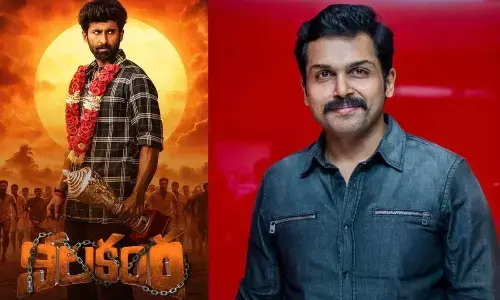Modi on horns of a dilemma

Modi on Horns of a Dilemma, Modi’s Campaign Style, Political Message. A weird political discourse is raging across the country. It is focused on the nature of Indian nationalism, and its natural attribute.
A weird political discourse is raging across the country. It is focused on the nature of Indian nationalism, and its natural attribute, secularism. As is now becoming so familiar with the BJP’s and, more significantly, Modi’s campaign style; the emphasis is clearly on constructing imagery to drive home a political message. And, currently there is an overdose of that defining feature.
It is increasingly clear that this new-found penchant for debating nationalism stems from a sense of extreme anxiety over acceptance over intermarriage between unstinted corporate support and political Hindutva. The key coinage that Modi has framed to unleash his campaign in the first person singular number: “I am a Hindu nationalist”.
But even the saffron brigade realises that this is a sticky wicket. The very notion of Hindu nationalism is widely recognised as a euphemism for unadulterated communalism because nationalism in the Indian context has evolved historically as an outcome of our freedom struggle. Obviously, the very nature of the Independence movement demanded united mobilisation of all sections of the Indian people irrespective of caste, creed, religious belief and all other diverse identities. Harmony, unity and secular belief was a necessary prerequisite. Naturally all these interconnected ideas became part of Indian nationalism. Summarising, Hindu nationalism is the antithesis of Indian nationalism.
But, the palpable discomfort of the BJP and Modi campaign is not merely on the theoretical premise of what defines Indian nationalism. It is far more real and embarrassing when it comes to finding an icon amidst the saffron fraternity which would suit Hindutva’s electoral requirements. Obsessed with the style of creating imagery is what is so irksome for the Sangh Parivar.
And that embarrassment forms the backdrop of the outlandish idea of creating the 180-meter-tall statue of Sardar Patel at a cost of Rs.2500 crores. In a way this is an affront to every Indian citizen who cherishes the legacy of the freedom struggle and Sardar Vallabbhai Patel’s contribution to national emancipation, not to speak of the injustice done to the personae of the Sardar himself. This obnoxious effort of manufactured symbolism cannot be divorced from the infamous sequence of images of razing the five century old Babri Masjid to the ground and then firing the imagination for construction of a ‘mandir’ in the name of Ram. The essence was to substitute reality with a myth; because Hindutva has nothing to do with religion; it is only about using religion to assume political power. This has been most tellingly buttressed by the BJP itself with its record on Ayodhya while the saffron brigade has been in office.
Therefore, search for a genuine and credible nationalism and its conspicuous absence within Hindutva ranks have propelled Modi and the BJP to pounce upon hijacking the Patel legacy. Audacious as it may be, the entire effort is directed at shifting the focus away from the role of Hindu Mahasabha and its leader Shyama Prasad Mukherjee; for the reality is that the Mahasabha evolved into the Jana Sangh and its present incarnation, the BJP. It is well-known that not only was the Mahasabha not opposed to British efforts, but it actually joined hands with the Muslim League in becoming part of the coalition governments in Bengal and Sind provinces.
Continuation of the ‘divide and rule’ policy of British colonial administration evolved into vivisecting the country. The Partition, therefore, was a purely British idea and a full one and a half years before the Muslim League and Jinnah became strong advocates of this British project, the Hindu Mahasabha had bitten the bait. So, it is hardly difficult to understand the predicament of the BJP and Narendra Modi. Can Shyama Prasad Mukherjee and Sardar Patel be the Hindutva brigade’s icons at one and the same time?
Given his intellectual level, even Narendra Modi is acutely aware of the absurd implications of that poser. Therefore, Modi is evasive on Patel’s nationalism and far more of his secularism. Instead, he is trying to posit Patel against Nehru. This is to insinuate that, on the question of nationalism and secularism Patel and Nehru were in opposite camps. Through such an effort, the Modi-BJP campaign is deflecting attention from its own legacy; instead, sparking a discourse on the nuanced differences between Nehru and Patel.
But that is not relevant in the current context; what is far more important is how and what is common between Patel’s legacy and what is being professed and practiced by Modi today. Obviously, that is an extremely embarrassing subject because Sardar emphatically disavowed the politics and ideology of the RSS.
Further, Patel was firm on forcing the Sangh and Golwalkar to commit that they would not have anything to do with politics as a pre-condition for lifting the ban on the organisation. It is a different proposition that the RSS has precisely reversed that public commitment with impunity to impose itself on the BJP leadership for anointing Modi as the Prime Ministerial nominee for the Hindutva camp.
Therefore, while Hindutva’s efforts at whipping up communal aggressiveness continue unabated, image makers worldwide are tutoring the Gujarat Chief Minister so that he can step into new shoes with a makeover on questions of nationalism and secularism. But this is proving to be a tough ask because ultimately history is cruel and unkind. It is difficult to get away with travesties of truth, be they on Patel legacy or his track record on dealing with Muslims in Gujarat during his ongoing tenure.
By staking his claim to the post of Prime Minister, maybe a little prematurely, he has placed himself and his record for scrupulous public scrutiny. That is why he is wary of an anti-communal platform and the campaign along those lines. Therefore, it is understandable that he and his corporate supporters would try their best to avoid that course. With such a cue, corporate-controlled mainstream media is at it. Therefore, notwithstanding strong protestations of the organisers, the anti-communal platform of non-Congress secular parties was sought to be dismissed as an opportunistic front. To the Modi campaign that line of argument is easier to handle.
Much as he may dislike it, by ‘throwing his hat in the ring’ he has to subject himself to scrutiny for what he actually stands for. And, surely, every attempt at myth-making will have to stand up to a reality check. That is a bare minimum for Prime ministerial aspirants.
Next Story

















